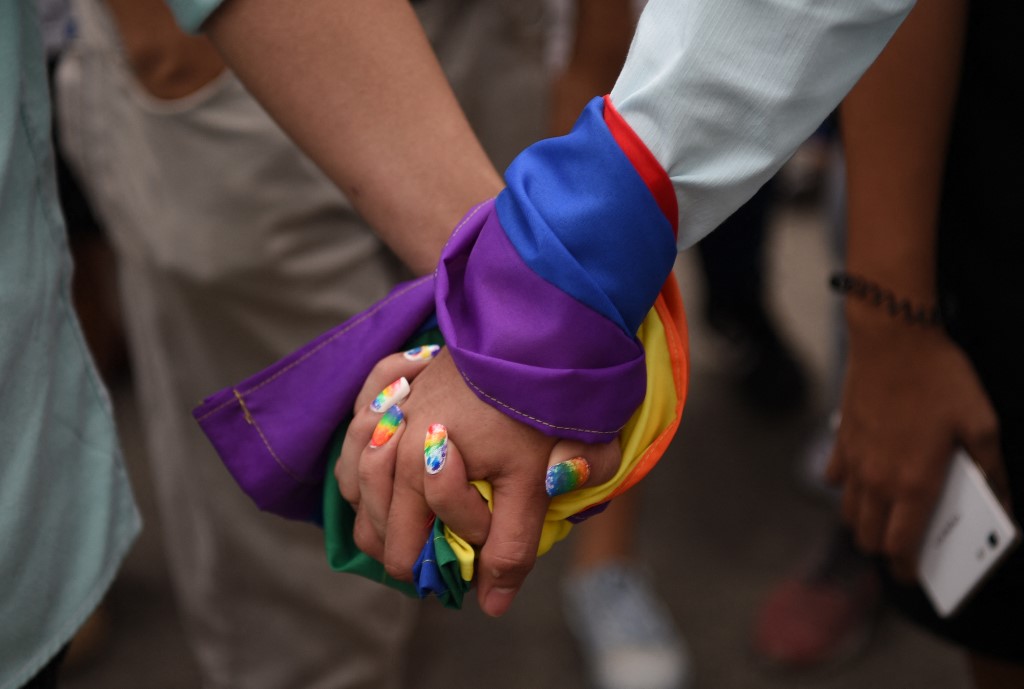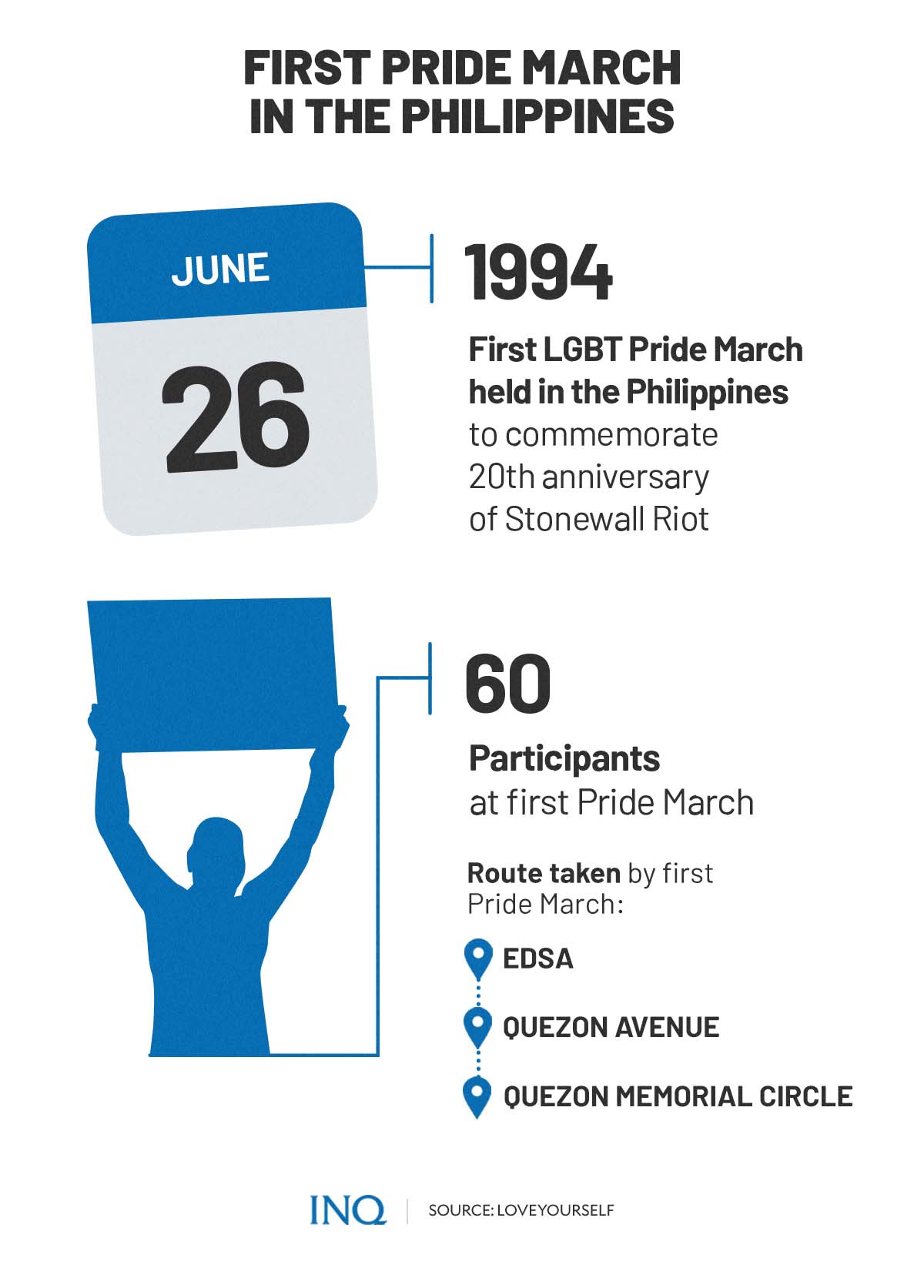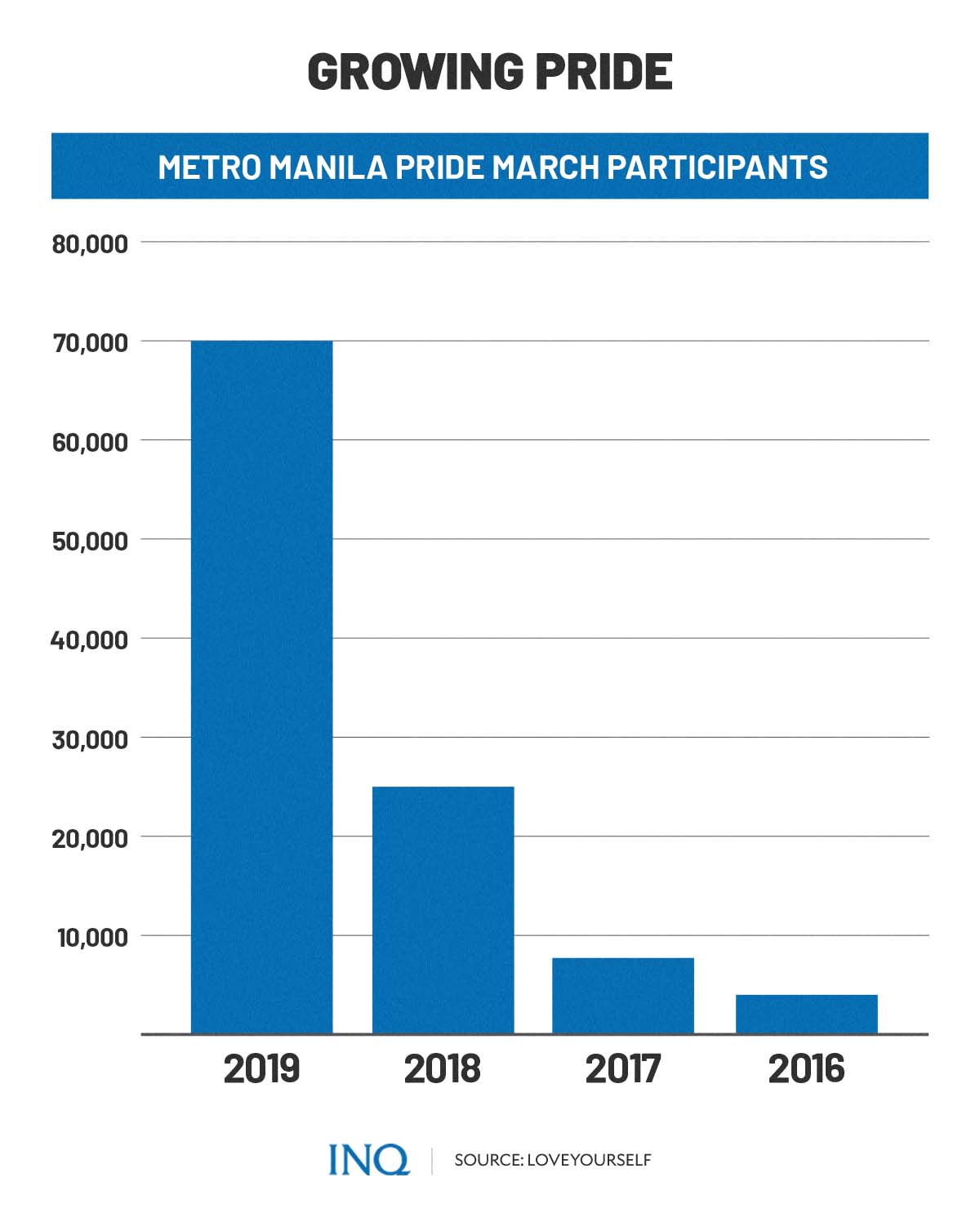PRIDE MONTH The memory of Stonewall Riot lives on

FILE PHOTO: A couple hold hands wrapped in a rainbow flag as thousands of Lesbian Gay Bisexual Transgender/Transexual Queer (LGBTQ) members hold a pride march at a sports complex in Marikina City, east of Manila on June 30, 2018. – Thousands of gay pride marchers braved heavy rain in Manila on June 30 calling for the legalisation of same-sex marriage as the Philippines’ top court considers a landmark legal challenge to the current ban. (Photo by TED ALJIBE / AFP)
MANILA, Philippines—In the early hours of June 28, 1969—during a period when homosexuality was clinically classified as a mental disorder—police raided the Stonewall Inn, a gay club in Greenwich Village in New York City, and bodily dragged employees and patrons out of the bar.
The raid led to the arrest of 13 individuals, including employees and people who violated the state’s gender-appropriate clothing statute. The police raid, however, did not end there.
“Fed up with constant police harassment and social discrimination, angry patrons and neighborhood residents hung around outside of the bar rather than disperse, becoming increasingly agitated as the events unfolded and people were aggressively manhandled,” History, an American television network, reported.
“At one point, an officer hit a lesbian over the head as he forced her into the police van— she shouted to onlookers to act, inciting the crowd to begin throwing pennies, bottles, cobblestones, and other objects at the police.”
Patrons and neighborhood residents fought back during the days-long uprising—then characterized as a riot. The movement, now known as the Stonewall Rebellion or Stonewall Riot, helped spark the modern LGBTQI+ (Lesbian, Gay, Bisexual, Trans, Queer, Intersex) civil rights movement.
In June 1970, a year after the riots, thousands of people participated in what was then known as the “Christopher Street Liberation Day,” a march that stretched from Christopher Street, where the raided bar was located, to Central Park—the event was later on recognized as the first gay pride march.
Since then, every June, several countries across the globe—including the Philippines—commemorate the legacy of the Stonewall Riot—which served as a catalyst for emerging LGBTQI+ movements years after the momentous event—through marches, rallies, and programs focusing on upholding the rights of the LGBTQI+ individuals.
This Pride Month, in this article, INQUIRER.net talked with some members of the LGBTQIA+ community and allies of the community about their thoughts on the Pride Month celebrations.
They also shared some tips and life lessons for other members of the community, including the LGBTQI+ youth in the Philippines, as well as for the activists who tirelessly continue to fight for the rights of every individual in the community who, up until now, experience discrimination and repression.
A special month
For Lhouric Medina, Pride Month is an important event in which he can celebrate his identity as a gay person, along with other members of the LGBTQI+ community.
“This is the time when we can celebrate ourselves. This is something that we should celebrate every year, we need to go out of our house and we have to tell everyone, we have to tell the world, that ‘Hi, I’m gay and I’m proud to be part of this community’,” he told INQUIRER.net in an interview.
Medina also noted that more people have started to join and celebrate Pride Month as more members of the community became louder and prouder of their identity.
Meanwhile, Don Moya described Pride Month as a “special and warm month.”
“Pride Month is a special and warm month to me as a gay person and it should definitely be celebrated every year because it is the time when the LGBTQ+ community feels the safest and free in expressing themselves along with the other people in the community,” said Moya.
“It’s also an important month where we remember all the members of the community who were lost because of the violence and discrimination caused by others,” he added.
Arshi, a trans-woman, shared the sentiments of Moya. She explained that Pride Month is celebrated to honor the members of the community who lost their lives due to violence and discrimination.
“We should celebrate Pride Month to remember the sacrifices and what our [previous] LGBTQ generation members did to have the freedom we experience today,” she said in a message to INQUIRER.net.
However, Arshi shared that she is not a huge fan of Pride Month.
“[To be honest], I’m not a huge fan of Pride Month because I believe that our community should not be well represented for only a month,” she explained, adding that “some businesses actually make it a market [strategy], claiming they are LGBTQ+ friendly but only for the month of June.”
READ: 12 Local queer-owned businesses to support beyond Pride Month
READ: 16 Queer entrepreneurs & artists to support instead of rainbow capitalism
More than just a celebration
Pride Month and Pride parades, however, are more than just a celebration of and for the LGBTQI+ individuals.
Rather, it is a protest, a means of speaking out on the concerns of the community—especially in fighting for the rights of every member of the community, most of whom still experience discrimination and oppression because of their gender or sexual orientation.
“Pride marches or Pride Month, in general, are more than a celebration. It’s been a protest ever since the Stonewall Riots happened. It started there. It was a protest to uphold the rights of LGBTQI+ individuals,” Anna Cubacub, president of the UP Babaylan, told INQUIRER.net in an interview.
It is important because it’s an avenue to voice out the grievances, the lived experiences of each individual, so that the community’s voice will be amplified and hopefully it will reach the authority and they will hear us,” Cubacub said in Filipino.
Clarisse See, vice president of UP Babaylan, said that “Pride Month or Pride march is a historical event that became a breaking point for LGBTQI individuals in the US to form a movement. Ever since, that was the essence of it, that we have a voice despite the rampant violence [against LGBTQI individuals] throughout the year, that we have an actual space to celebrate our identities.”
UP Babaylan is the premier and longest-existing duly recognized university-based student LGBTQ+ organization in the Philippines and in Asia.
From a small crowd to a huge movement
Pride Month, or pride parades, in the country, according to Medina, began with a small crowd but were later on celebrated and participated by many people as more members of the LGBTQI+ community became more confident and comfortable in expressing themselves and celebrating their identities.
“It started with [a small crowd] of LGBTQI+ [individuals] but it grew because many went ‘out’ and became loud and proud of who they are,” he said.
READ: Being gay in PH: Living life to the fullest
On June 26, 1994, the Progressive Organization of Gays in the Philippines (PROGAY Philippines) and the Metropolitan Community Church (MCC) Manila organized the first LGBT Pride March in the Philippines to commemorate the 20th anniversary of the Stonewall Riot.
It was the first pride march in the country and in Asia.
Although the march was small in number, with only 60 participants marching from EDSA to Quezon Avenue to Quezon Memorial Circle in Quezon City, it was the first pride march, not only in the country but also in Asia.
The participants carried placards and chanted for equal rights.
“It was the first time anyone on television saw someone gay on the street with a political placard, and with a political slogan on it, verbalizing human rights for themselves,” said Filipino gay activist Oscar Atadero in an article published by Fridae, “a diversified media and services company that caters to the gay and lesbian community of Asia.”
In a Facebook post, Richard Mickey, who was an MCC pastor when the first pride march in the country took place, reminisced about the event saying:
“Remember this was the first. Not everyone was ready, willing, and bold enough to expose themselves to media. There was minimum newspaper coverage. But the media picked it up and it spread like wildfire. Talk show after talk show invited us. ‘Mel and Jay’ was the most popular talk show in the country at the time. They invited me and others twice.”
However, it took two years before the next march took place. The 1996 Metro Manila Pride march was considered by some as the first pride march in the country as it was the first one that was organized by a huge queer community.
The movement, as Medina said, continued to gather more participants—including members of the LGBTQI+ community and allies of the community—as years passed. This was evident in the number of attendees of the previous Metro Manila Pride marches held prior to the COVID-19 pandemic.
The Metro Manila Pride march in 2016, with the theme “Let Love In: Kahit Kanino, Kahit Kailan,” was attended by 4,000 individuals. The following year, an estimated 7,718 people gathered for the Pride march with the theme “Here Together.”
In 2018, “Rise Up Together” gathered around 20,000 participants. The numbers tripled in 2019 when the Metro Manila Pride march—with the theme “Resist Together”—was attended by at least 70,000 individuals.
‘Celebrating’ Pride Month
When asked, “How will you celebrate Pride Month this year?,” both Moya and Arshi said they plan on attending the Pride march and events with some friends.
“This year, I’m planning to finally attend the pride march as I’ve never been to a pride march actually [because] before I leave the house and go somewhere, I have to ask permission from my mom first—and I don’t know how I will tell her [that] I plan to go on one because I’m not really that open in my home, although I’m pretty sure they’re aware I’m gay. But yeah, hopefully, this year I get to attend,” said Moya.
“Maybe, [if I have any plans], I would go to an event and meet some queer friends,” said Arshi.
Meanwhile, UP Babaylan has prepared programs and events for the month of June, in celebration of Pride Month.
Among these programs—all of which can be found on their official Facebook page—is their online fund-raising initiative called “Art for a Cause.”
“We put together a team of queer artists who volunteered to create stylized, stylized-cartoon, and stylized-realistic portraits for clients who want to support the LGBTQI community,” UP Babaylan said in a Facebook post.
“For a minimum donation of 300 pesos, you can receive a personalized portrait while sharing your love and generosity with our lolas from the Golden Gays and our trans siblings from Pioneer FTM!”
What keeps them going
Despite the challenges and discrimination they experience as members of the LGBTQI+ community, Medina, Moya, and Arshi found their own sources of strength to keep them going in life.
Medina said his inspiration as a queer person is his mother, who wholeheartedly accepted his identity and supported him—and fellow members of the LGBTQI+ community.
“I am very much proud to say that my inspiration for being who I am right now is my mother because I never heard any [questions] from her [regarding my gender], to think that I am the eldest among my siblings,” he shared.
“[My mother] always tells me ‘you’re one of my [source of] happiness’,” he said, adding that he also felt the same strong support from other family members.
“My mother is my inspiration, she always tells me how much she loves gay people because she has a gay son. Whenever she goes to the beauty parlor, she will give tips to gay hairdressers and manicurists because she sees me in them. I know that she is 100 percent proud of who I am,” Medina said.
Moya meanwhile said he was inspired by other members of the LGBTQ+ community.
“Honestly what keeps me going is seeing other members of the community being successful in their lives with their partners gives me hope that someday I’ll get to experience the same for my life,” said Moya.
On the other hand, Arshi said she found support from fellow queer people.
“My LGBTQ+ friends [are my source of strength] because we help each other to be strong despite the hardships that the society gives us,” she said.
Advice to LGBTQI+ individuals, youth, activists
Medina, Moya, Arshi, Cubacub, and See, as members and allies of the LGBTQI+ community, shared some words of wisdom and tips to the LGBTQI+ youth and those who have yet to “come out.”
“Let’s give time to those who have yet to come out because coming out should not be forced, they should be mentally and emotionally prepared,” said Medina.
“Don’t rush yourself, don’t put pressure on yourself. You need to mentally and emotionally prepare yourself before coming out…[because] this is one of the biggest chapters of your life,” he added.
Moya said: “Take your time in figuring out yourself and NEVER be afraid to be you. Always remember that you are always loved no matter who you are.”
“For those who are not out yet, don’t rush and look for safe spaces or peeps (people) you can open out to and maybe work hard on yourself—a part of this is [working on your] education because only you will carry yourself in the end,” Arshi advised.
“Lastly, [make] right choices,” she added.
Both Cubacub and See gave the same advice.
“For the LGBTQI youth, we always tell them that they don’t need to come out if they don’t want to do so. [Also], your coming out story is yours alone and no other person has power to out you and, if due to unfortunate reasons, that will happen, you have the power to reclaim it,” said Cubacub.
“You can come out on your own time, whenever you are ready. You don’t have to rush,” she added.
She also reminded the next generation of the LGBTQI+ community that there are people before them who are fighting for the rights of every individual in the community.
“Just know that there are people who [make sure] that the society that the LGBTQI youth or the next LGBTQI generation [will grow up in will be] less harsh for them,” she added.
See also advised the LGBTQI+ youth to find a community “where they will be able to just be themselves” and one that can assure their identities.
“Power is established, especially among the minorities, when they are in groups,” said See.
Cubacub and See likewise left some advice to fellow activists who are fighting for the rights and safety of the LGBTQI+ community.
“For the LGBTQI activists, this is going to be a very long fight. Don’t lose heart. Even though there are many setbacks and hindrances, all of our blood, sweat, and efforts to achieve a society that is accepting of who we are will not be for nothing,” said Cubacub.
“This will be a long fight,” said See.
“Even though it can be exhausting at times, let’s keep going because something will surely happen. This will have an impact, even though we can’t see it yet…For now, we can’t see the effects of what we are fighting for but in the future, we might be able to see it,” she added.
“Rest. Just like what Senator Risa Hontiveros once said, ‘rest is part of your revolution.’ There is nothing wrong with taking a break, what’s important is that we continue to fight,” she continued.

